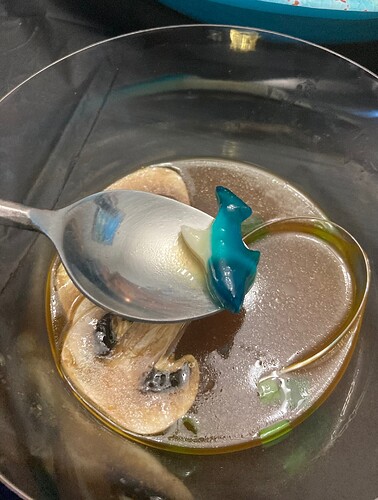It sure will fuck E. coli up, and an E. coli cell is a fabulously interesting world. The whole T-phage family is hell on those little guys. Too bad microbiologists give everything such boring names. The fruit fly people are much more creative.
Cute but deadly. Doesn’t it spear the victim after grasping it with those formidable legs?
PS. I remember the drosophila melanogaster from many days in the genetics lab with Dr. Stein. Red eyes, white eyes?
Not quite alive by most standards, but I must confess to being rather fond of the generic icosahedron atop a slim, cylindrical body with spider legs form that is the common placeholder image of what a virus looks like… which raises the question of whether any virii actually look like that and which ones are made the poster child for the Virus clade.
I’m also reminded of the plush microbes I remember seeing on Think Geeklike 15 years ago that I always wanted but never actually bought.
That is in fact the T4 Amanda mentioned!
Frank N. by any chance?
Yup! I was actually about to write an image description for what Amanda posted, but you beat me to it, lol. That’s exactly the virus in her image.
I still think it’s mind-boggling that something in nature just looks like that. The world is made of tiny machines.
Kind of. It latches on by biochemical attraction, walks around a little (no kidding!) looking for the right receptor, drills a little hole in the membranes and cell wall, ejects the very end of its genetic material in, and the poor bacterial cell pulls the rest of the viral DNA in with its polymerase. The capsid (body) is just trash then. The host cell does nearly all the work, as is usual with viruses.
Anyone else get retro sci-fi mining robot vibes from that description of a virus infecting a cell?
And the amazing part of all this cellular machinery is that it works so well despite being the product of random iteration.
And yeah, it’s amazing how many seemingly artificial structures in geometry actually occur in nature if you know where to look…
Gerald J. - He became very involved with AIDs research. I stayed in touch with him through the end of the 90s.
Did I mention his 12 hour Human Genetics final exam? (It was worse than my day long comps at Texas Tech.)
I spent a few hours pruning the garden today and hoping I didn’t make our neighbors mad (dead flowers were spilling onto their sidewalk and snipping them made it look even uglier). also got mosquito bit 22+ times (I counted)
A neighbour gave us a week ago the SCOBY that you need to make kombucha, so we put tea with sugar in it, and now it seems ready! I think. It’s, uh, a pretty weird thing, and swear it could probably take over the world given enough time. ![]()
SCOBY? Is it legal? ![]()
I wish I got the joke, but alas, I’m not good at these, lol.
My sense of humor is drier than the Mojave Desert…
The adventures of friend-finding continue!
I woke up to find a small house centipede (Scutigera coleoptrata) in my shower. Into the jar! I didn’t look up what it was before releasing it outside, and mistook it for a kind of millipede, so I think it was disappointed when I placed it on a patch of moss, lol. Oh well.
Came back inside, and sat down at my computer to start chugging water (I often wake up super dehydrated). That’s when I saw a juvenile cellar spider, rappelling down from my ceiling. Into the jar! I don’t think it even noticed that it had been contained. Usually spiders will climb back up the line when panicking, but this one just kept calmly and slowly moving down the line.
At this point, I keep a glass jar in each room for convenient capture. Most bugs can’t crawl on glass, but I keep a lid handy anyways, because I have noticed that spiders are able to glue web lines onto glass surfaces, so it’s only a matter of time before I find a spider who exploits this to crawl out of containment. Also, I’m eventually going to be surprised by a bug that is naturally able to climb glass, so better safe than sorry!
You definitely need to be a science teacher!!!
My Periodic Table d120 arrived today.
What’s a periodic table d120 you ask?
It’s a metal d120 that, instead of being numbered 1-120 like a normal d120, it has the symbols of the 118 chemical elementas laser etched on 118 of the faces, with the last two faces being a radioactive symbol and an old school model of the atom.
It is epic and very nerdy.
That is amazing!!
My phone’s terminal and mini-computer are both low-power, and are designed to lean on services that my desktop provides on the local network, which creates a sort of single distributed computer.
However, there are times where the phone and mini cannot connect to my desktop, and for times where I’m on a different network entirely, I don’t want these symbiotic systems to tattle on themselves in their attempts to search for my missing desktop.
So now, I have a script on my phone and mini which performs checks before attempting any network tasks:
- Is the device connected to a local network at all?
- If not, the check fails here.
- Poll the local router for its MAC address
- If the MAC address does not match the one of my home router, then the check fails here.
- Ping the static local IP of my desktop.
- If there is no reply, then the check fails here.
- If nothing fails at this point, then the device is cleared to perform a symbiotic network task.
This might be overkill but gosh it feels clean. ![]()
